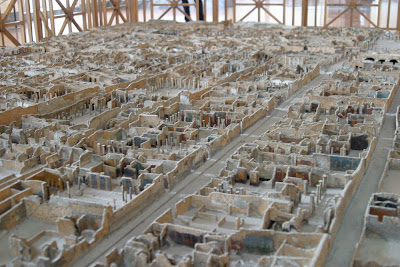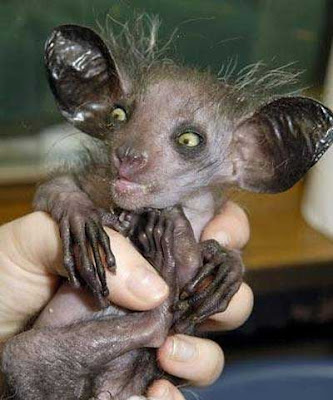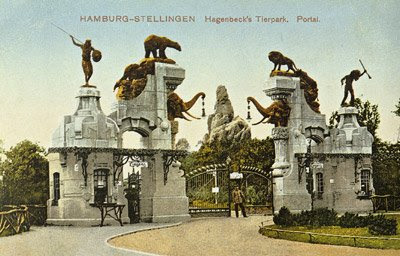
People have been fascinated by miniatures for millennia. The ancient Egyptians made miniatures of the things which a dead person should have in the afterlife; the Romans were very fond of lewd little figures for self-apparent reasons. There are endless tiny sculptures of gods and goddesses from the Stone Age through the Bronze age and onward.

There are, of course, mundane examples of miniatures, things that are neither romantic nor religious. I encountereded some when we went to Croatia: moving to another country with children is tricky. What toys do you take? What other supplies? Puzzle books? Journals? (No, this is not going to be a "parenting is wonderful" blog post).
My answer to that is: Playmobil. Plenty of Playmobil.
If you're not familiiar with the stuff, imagine a company that makes sets of what my family calls "little people," about two inches high, with almost any tiny attendant articles you could imagine for what my kids call a "set-up:" A roman colosseum, for example, with lion, tiger, gladiators, weapons, and even an emperor to give the "yea" or "nay". Knights and castles; pirates and pirate ship (including working cannon and cannon balls, guns, swords, and a little island with a skeleton); native americans with tipis and bits of rocky landscape, complete with plants and waterfall. And on and on.

My personal favorites are the Safe-Crackers, who all sport five o'clock shadows and come with a safe, money, gold bars, a suitcase, a flashlight, and a tank of acetylene. Or the HazMat people, with suits and masks and special clean-up vacuums.

In any case, the best thing about Playmobil is that, if your kids are (like mine were) stuck in a foreign place with no friends, they can get
really creative with it. In fact, it wasn't until we did go away that I fully appreciated the power of childrens' play and the incredibly flexible possibilities in that kind of miniature universe. Not so much that the HazMat crew can become astronauts, but that the fence-panels can become a tree-platform can become a house can become a raft, with the onion bag from the kitchen as a fishing net. And so on.
But most importantly, they are
small. Whole worlds can be created, stories unfolded, and imaginary landscapes enacted. It is better than TV, because it is
under your control. The tininess allows you to make things happen, and if you're someone (like a child) who has little say in what happens around them, it is a boon.
One short story which had a great impact on me when I was a kid was
Microcosmic God, about a man who creates his own race of tiny, intelligent creatures, whose generational span was very small, and who could therefore evolve fast enough to tackle all kinds of problems and discoveries. He has a way of communicating with them which was a bit like a teletext machine to God. When the government finds out what he's doing, they send bombers to destroy the island, so the scientist asks his little people to protect him: and they do. A smooth, impenetrable wall is erected, bomb-proof and pretty much anything-else-proof, and so there he is, trapped in there forever with his little people.
This story kept coming back to me when my kids, isolated from Croatian children's culture and unable to make any headway at the local parks, would retreat to their room and take up the little people. Voila! Protection, microcosmic-style.

Controllable mannikins aside (where is Mini-me when you need him?), there is something about tiny reproductions of our inner and outer life which continues to fascinate us. Wandering around in Napoli, Italy, on the way back from the wonderful
Ospedale delle Bambole, I got lost, and found myself in a district where they sell all kinds of tiny figures and items to do with the creches, or nativity scenes, of which the Neapolitans are so proud.

There were tiny baskets of fruit, tiny wagons, tiny tools, tiny trays full of tiny fish; there were miniature sausages and angels and people burning in hell (what that has to do with nativity scenes, I have no idea). There were political figures (in varying sizes) and teeny-weeny loaves of bread. The creches themselves, I learned, are traditionally made from natural materials: cork bark, wood, and moss, and are prized for their natural-seeming rustic quality.


They were completely absorbing: we looked at tiny things for literally hours. The array was stunning. You could barely walk from one shop and you'd find another shop, with entirely different sets of the same kind of stuff. They even had DIY bambole (dolls):

(Curiously, sprinkled in among them were other strange and tiny things, things that couldn't possibly be related to creches. For example, tiny versions of the red peppers that seem to be symbolic of some very particular Neapolitan magic, whether for good luck, or fertility, or what, I could never tell -

- except I got the sense that it was related to the Comedia del Arte's
Pulcinella character - the precursor to Punch - a personality whom the Neapolitans clearly identify with. There was one display which had statues of Pulcinella as well as relatively large models of his mask, with a long nose, and larger (nose-sized) red pepper things - and several rather similar things which were decidedly phallic, leaving me wondering what, exactly, the symbolism of the peppers might be.)

Later, in the Archeological Museum, I came across this mind-boggling miniature Pompeii, the ruins of which lie just across the Bay of Naples. It is a perfect 1:100
scale model and shows the excavation as it was in 1879, complete with some of the paintings before they were worn away.

After I walked around it for awhile I noticed a little info plaque which told me it had been made from cork-bark and bits of wood - just like a creche (and thus, by conjecture, made by local model-makers in the creche tradition). It reminded me of the work of
Charles Simmonds, who in the 1970's used to build tiny buildings out of teensy clay bricks into the neglected buildings and odd urban corners of Manhattan. I only know of one which survived, and it's in the stairwell at the Whitney, left over from his show there.

What makes people so obsessed with making tiny scenes? Prisoners building bridges and towers out of toothpicks, boys and their model airplanes. There is a level of control, as I said - one only has to look at the wide world of gaming miniatures and dioramas, famous or fantastic battles modeled on a 1" to 6' scale, to see a desire to manipulate worlds, to be the microcosmic god and step back from the painful intimacy of everyday life (I am ignoring the strategy side of this hobby, but still... actual miniatures are not necessary to the study of strategy - they just make it more fun).
I won't go too far into the idea of actually shrinking real people so that they are miniature versions of themselves, like in the Twilight Zone, where the people discover the sink doesn't work and all the food is made of plaster. But think of the old wives' tale about the witch who put her husband in a bottle. And then, of course, there's the miniature of a real person, containing nail clippings or hair from that person, said to be so powerful in voudun. How satisfying, to reduce your enemy to doll-size and then inflict all manner of misery on them! Of course, there's always the chance that they will do the same to you... and I have to admit to a creeping horror of anything small which might be alive (see my post on
puppets and humuncula).
...But miniatures are not only about godlike manipulation. Maquettes, for example, are models built to help explain an architectural or sculptural commission to people who are no good at understanding arm-waving and verbal explanation: "[A maquette] is used to visualize and test shapes and ideas without incurring the cost and effort of producing a full scale product. It is the analogue of the painter's cartoon or sketch." [wiki] By building a scale model, the sculptor or the architect can make a layman "see" what they're getting - and at the end of the day, some maquettes become valuable in their own right, and are displayed by such museums as the
Museo dei Bozzetti, in Pietrasanta, Italy.
Similarly, traveling salesmen as far back as the 1700's would carry perfect miniatures of their products so that prospective buyers could examine the merchandise before putting in an order. If you wanted a set of chairs, for example, you would look at the miniature to see how well it was put together. If the miniature was good, chances were that the real thing was good, as well. This was especially handy for such things as iron fireplaces and ceramic fixtures, like toilets, which were carried about the countryside to sell product to far-flung individuals.

In the seventeenth century, at about the same time that Wunderkammern were in vogue, "baby houses" - a precursor to dolls' houses - were all the rage among European women, comparable in obsession to the cabinets which housed their husbands' collections. A woman might spend as much money on one of these "cabinet houses" as a real house would cost. The one above "...was commissioned by Petronella Oortman, a wealthy Amsterdam lady. The house is remarkable in that all of the components are made exactly to scale. Petronella ordered miniature porcelain objects from China and commissioned furniture makers and artists to decorate the interior." (courtesy of the
Rijkmuseum in Amsterdam).

Then there's Queen Mary's doll house, made on the whim of "...the queen's cousin, Princess Marie Louise, who discussed her idea with one of the top architects of the time, Sir Edwin Lutyens at the Royal Academy Summer Exhibition of 1921. Sir Edwin agreed to construct the dollhouse and began preparations. Princess Marie Louise had many connections in the arts and arranged for the top artists and craftsmen of the time to contribute their special abilities to the house. As a result, the dollhouse has an amazing collection of miniature items that actually work... The bathrooms are fully plumbed that includes a flushable toilet and miniature lavatory paper. In addition, well known writers such as Rudyard Kipling and Sir Arthur Conan Doyle wrote special books which were written and bound in scale size, and painters provided miniature pictures. Even the bottles in the wine cellar were filled with the appropriate wines and spirits, and the wheels of motor vehicles are properly spoked."

And that, I think, is taking it too far, although my 6-year old daughter (the proponent of Playmobil) might disagree.
Links:-
Little handpainted people, left in London to fend for themselves: this is wonderful and amazing.
- Playmobile as
prep for an operation- Playmobil
re-enactments of news items:

- A very interesting, if dense,
article about miniatures, childhood, and fetish in the Quay Brothers'
Street of Crocodiles.
...And lastly, I came across this
extremely creepy video when looking for stuff on the Opedale delle Bambole - look carefully, and shudder
















































